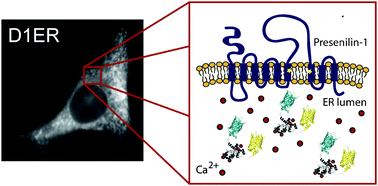The ER plays a fundamental role in storing cellular Ca2+, generating Ca2+ signals, and modulating Ca2+ in both the cytosol and mitochondria. Genetically encoded Ca2+ sensors can be explicitly targeted to the ER to directly define Ca2+ levels and monitor fluxes of Ca2+ within this organelle. In this study we use an ER-targeted Ca2+ sensor to define both the level and dynamics of ER Ca2+ in cells expressing mutant presenilin proteins. Growing evidence suggests the enigmatic presenilin-1 plays a role in regulating ER Ca2+. Presenilin-1 was initially identified in a screen for genetic causes of inherited familial Alzheimer's disease (fAD). The connection between presenilin-1, calcium regulation, and Alzheimer's disease may provide the key to understanding the long-observed, but poorly understood, link between Alzheimer's disease and Ca2+ dysregulation. In this study we examined seven fAD-causing mutations in presenilin-1 to define how they influence ER Ca2+ levels and dynamics. We observed that some, but not all, mutations in PS1 decrease the level of Ca2+ within the ER and this difference depends on the enzymatic activity of PS1. Two mutations tested altered the kinetics of Ca2+ release from the ER upon ATP stimulation, resulting in faster spiking. Combined, these results indicate that mutations in PS1 can alter the balance of Ca2+ in cells and have the potential to influence the nature of Ca2+ signals.

You have access to this article
 Please wait while we load your content...
Something went wrong. Try again?
Please wait while we load your content...
Something went wrong. Try again?


 Please wait while we load your content...
Please wait while we load your content...